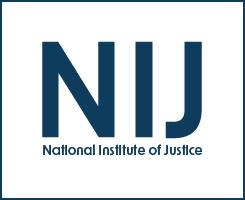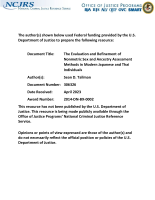American Indians or Alaska Natives
Native Missing Persons Cases Will Not be Solved by Police Alone The Case for Missing Persons Advocates
Missing Native American Persons: Nebraska Study Details Scope of Problem, Urges Culturally Sensitive Research and Better Access to Justice
Just Science Podcast: Just Sexual Assault Response in Indigenous Communities
The Evaluation and Refinement of Nonmetric Sex and Ancestry Assessment Methods in Modern Japanese and Thai Individuals
Refining Asian Ancestry Classifications via Cranial Macromorphoscopic Traits
Investigating Disparities in Behavior and Care Between Alaska Native and White Victims of Sexual Violence: The Importance of Culturally Competent Nursing Care
Gender-Based Violence and the Latinx Community
See the YouTube Terms of Service and Google Privacy Policy
Embracing Tribal Culture to Build Research Partnerships
NIJ Awards Over $11 Million to Support Forensic Science Research and Development in 2022
On September 30, 2022, NIJ announced $11.6 million in funding to support 23 projects under the “NIJ FY22 Research and Development in Forensic Science for Criminal Justice Purposes” solicitation. Through its research and development grant funding, NIJ continues to advance the speed, accuracy, and reliability of forensic analysis, which ultimately bolsters the...
Improve craniometric ancestry estimation with deep learning methods
The Effectiveness of Forensic Genetic Genealogy Techniques for Black, Indigenous, and Persons of Color
The Adaptation and Evaluation of the Fourth R Youth Dating Violence Curriculum for Indigenous Communities
Identifying the Scope and Context of Missing and Murdered Indigenous Persons (MMIP) in New Mexico and Improving MMIP Data Collection, Analysis, and Reporting
Assessing the Effectiveness of Interventions Designed to Reduce Racial/Ethnic Disparities in the Justice System: A Systematic Review and Meta-Analysis
Ethnically Diverse Adolescents Recount Third-Party Actions That Amplify Their Anger and Calm Their Emotions After Perceived Victimization
NIJ Recidivism Challenge Report, Team Klus
Tribal Crime, Justice, and Safety (Part 2)
Tribal Crime, Justice, and Safety, Part 2
Stacy Lee Reynolds and Christine (Tina) Crossland continue their discussion of tribal crime, justice, and safety, including how Native American persons experience crime victimization at higher rates than non-Native people and the jurisdictional complexities in responding to tribal crime, justice, and safety. Read the transcript.
Listen to the first half of Stacy and Tina’s discussion.
Reading and Resources from NIJ
Tribal-Researcher Capacity Building Grants
National Juvenile Court Data Archive: Final Technical Report
Tribal Crime, Justice, and Safety
Tribal Crime, Justice, and Safety, Part 1
Research indicates that Native American persons experience crime victimization at higher rates than non-Native people. Furthermore, the unique position of American Indian and Alaska Native tribes as both sovereign nations and domestic dependents of the U.S. creates jurisdictional complexities in responding to crime, justice, and safety. Senior social and behavioral scientist Christine (Tina) Crossland discusses NIJ’s research on these topics, especially on the prevention of violence towards American Indians and Alaska Natives. Communications Assistant Stacy Lee Reynolds hosts.








